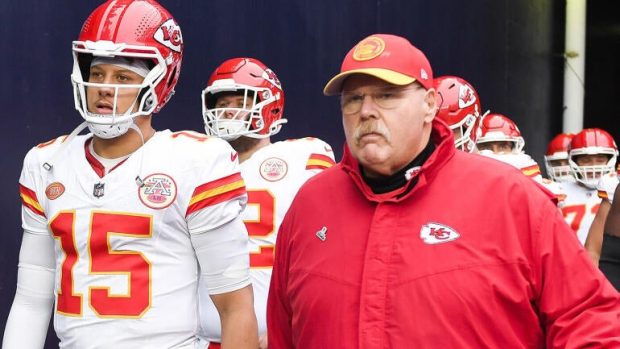I own the distinction of being the least successful panelist to ever appear on “Around the Horn,” ESPN’s longtime roundtable debate show.
There have been 60 “Around the Horn” panelists. Of the group, 53 won an episode at least once, including my The Athletic colleague Dianna Russini, Mark Cuban and Lil Wayne.
Advertisement
Seven of us were winless. But no one ever appeared more times without a win than I did.
For those unfamiliar with “Around the Horn,” its format is a group discussion of the day’s top sports news, featuring a host — for the last 21 years, Tony Reali — and four sports pundit panelists. Reali awards points for good arguments, and the top point-earner of each episode earns that day’s win.
When “Around the Horn” completes its final show Friday, after 23 years and 4,953 episodes, my legacy of futility will be secure.
Confession: My unmatched winless record is a point of enormous pride.
When new panelists appear on the show for the first time, they inevitably win (a fun tradition that I still managed to botch). I feel like the 1972 Dolphins when the last unbeaten team during the NFL season finally loses.
I have a few other confessions to make about my erstwhile “Around the Horn” career.
Confession: My “Around the Horn” experience started with a lie (of omission)
The roundtable’s original premise was to feature top newspaper sports columnists from different regions of the country. When it launched in November 2002, I was about to start a daily column for ESPN.com’s old “Page 2” section, and I naively vowed to find my way onto the show.
There was one glaring hurdle: I had zero on-air TV experience.
When original host Max Kellerman (who left after a few years, making way for Reali) emailed me, a year or so into the show’s run, to say that the production team had read and enjoyed my column, he also relayed the most loaded question I had ever received:
“Are you any good on TV?”
My honest answer would have been, “No, but I have always imagined I would be!”
I didn’t lie — I would say I more elided that truth in favor of an entirely honest enthusiasm to participate, hoping they wouldn’t ask that question again.
After a few fits and starts, I was scheduled to appear on June 14, 2003.
Confession: Imposter syndrome is real
During the lead-up to my first appearance, I tried to simulate on-air TV work to make up for the lack of actual on-air reps.
I watched the show every day, transcribing all the topics and running through how I would have responded to them. I used a video camera and taped myself giving glib answers to the lens, rather than staring at notes or looking off to the side, which would instantly reveal that I was a TV noob.
Advertisement
When the week of the show arrived, my train ride down from NYC to D.C. for the taping triggered a thousand anxious words in a journal. And arriving at the studio the next day to tape the show was terrifying, largely manifesting as flop sweat. Having no experience doing TV means, of course, you have no experience doing TV. “Fake it till you make it” can be terrible career advice.
To this day, I wonder if the producers were in the control room going: “Oh, god, what have we done?”
This was not anything like sitting around the lunch table with my college buddies, debating sports. The content mattered, but there was the complication of creating a TV product: following guidance from producers and directors in your earpiece, not blanking on my overly rehearsed talking points, looking at the camera lens and not, say, compulsively off to the side. (Oops.)
But then came the payoff: Being on the show was incredible. At least one self-congratulatory moment of “I can’t believe I pulled this off”; at least one cynical moment of “Now I can say I have TV experience.” Tons of people emailed or called to say they’d seen me. I envisioned a future as a famous sports TV pundit.
It would take nearly a year to get back on the show.
Confession: “Around the Horn” drove me to start smoking
If you strolled near Union Square in the spring of 2004, you might have seen a nebbishy 31-year-old fumbling with a cigarette, coughing, possibly muttering to himself.
That was me.
When I returned to the show in late May 2004, panelist Woody Paige made a joke on-air comparing me to “Topo Gigio.” Admittedly, it was an impressive pull: Topo Gigio was a popular character in 1960s pop culture — a mouse puppet who appeared on the old “Ed Sullivan Show.” And Topo Gigio had a very distinctive voice, high and reedy.
So did I. (“Still do!” he trilled.) Being a lifelong “high-talker,” it’s not like I didn’t know this was how I sounded. I took the gibe in stride — a little friendly hazing of the new kid.
Advertisement
But I also immediately committed to giving my TV voice more of an edge. And I decided the fastest path was to start smoking cigarettes. You know, rough up the windpipe a little bit, hopefully drop a half-octave or so.
It was a deeply flawed idea. I looked like a poser. I felt like a moron. Who starts smoking to advance their barely existent TV punditry career? I would have been better off shouting myself hoarse.
My effort lasted maybe a week. Then I abandoned my nascent Camel Light habit and resigned myself to chirping on-air.
Confession: I might be indirectly responsible for the “Embrace Debate” era
The GOAT of “Around the Horn”?
Undisputed: It’s Woody Paige.
From meticulous stats maintained by ESPN’s Caroline Willett of the “Around the Horn” production team, Paige made 2,965 appearances (first all-time by 850 shows), with 689 wins (first all-time by nearly 140).
I have a recollection that is part true, part hazy memory, part projection I would very much like to believe is accurate: Shortly after the debut of ESPN’s happy-go-lucky morning show, “Cold Pizza,” the network was figuring out how to bring a more contentious sports debate vibe into the show. The idea was to pair Paige with someone else to debate the big topics of the day in a special segment.
Past the haze of two decades, I remember one of the “Around the Horn” producers telling me — and he might have been idly gassing me up, it’s all fossilized in my memory — that he either floated, or wanted to float, my name to ESPN’s then-honcho of programming, Mark Shapiro, as a candidate to be Paige’s partner. In my naivete, I saw the vision. This was it!
Right around that time, Paige and I went to the old ESPN Zone restaurant in New York City for a meal together — obviously, no hard feelings about the “Topo Gigio incident” — and I would like to think he was determining if we had any chemistry. On the other hand, he might have just been being nice to a younger colleague. My most vivid memory of that meal was that he was approached probably a half-dozen times by fans, and was warm and friendly to all of them, a true mensch.
Advertisement
This part is entirely speculative, but I like to imagine that Shapiro gave me about 1.7 seconds of consideration for the “Cold Pizza” role before dismissing the idea. (More likely, it was a Don Draper-esque “I don’t think about you at all.”)
Fast-forward a few months: Shapiro went with Skip Bayless to pair with Woody, the “Embrace Debate” era began, “Cold Pizza” begat “First Take,” Stephen A. Smith came on board, and I will take no responsibility for the era of sports discourse that emerged from there.
Confession: 21 years later, I remain bummed it didn’t work out for me
My career lasted five episodes — not quite Moonlight Graham, but also not exactly Mina Kimes (304 appearances, 88 wins).
After my appearance in August 2004, the panelist slots became harder to get. There were more promising on-air talents to put on air, and I finally realized that my window was shut.
Mortifying side confession: For years after that, I couldn’t watch the show. It was too painful a reminder of what I had and lost.
I have all my episodes on VHS. (VHS!) I have thought about digitizing them, about editing some sort of humorous highlight reel of wrongness (2004 NBA Finals, to a national audience: “Lakers over Pistons in 4!”), about showing my teenagers that, yes, your dorky dad was once on ESPN. The reality is entirely the opposite: I cannot bring myself to watch those old tapes, let alone share them with my kids or the internet.
There is a lingering feeling that I wasn’t good enough, a nagging validation of the original imposter syndrome. I like to tell myself that I was simply too early; a few years after my appearances, the original rotation of newspaper-based panelists made room for more ESPN-centric talent — less experienced, internet native.
Over 23 years, “Around the Horn” morphed from a lucrative, gate-kept career benefit for tenured newspaper sports columnists to what I would argue is the most impressive incubator of on-air talent in sports media history.
Advertisement
Alumni include Kimes of “NFL Live,” Michael Smith and Jemele Hill of “His And Hers” (then “SportsCenter”), Bomani Jones of “Highly Questionable,” Pablo Torre of “Pardon the Interruption” (then paired with Jones on “High Noon”), Kevin Clark of “This Is Football,” Sarah Spain and Clinton Yates of ESPN Radio, Kate Fagan of “E:60” and even Adam Schefter, from his pre-ESPN days at The Denver Post (five appearances, two wins).
I would like to believe that I’m part of the show’s unique legacy of platforming a massive range of voices. The original “regional” model made way for a vastly more interesting variety of perspectives.
Last confession: I snuck over to NYC’s South Street Seaport on Tuesday to watch a taping of the show during its final week. They produce it out of D.C., but Reali hosts out of a New York studio, and I wanted to thank Reali, the soul of the show, in person. I found the closure of one last trip to the “Around the Horn” set appealing. Despite it being 21 years since I last saw him, Reali greeted me like an old friend, and sitting in the studio watching him deftly host the show felt comfortable, not anxious. My 30-something’s flop sweat was replaced with a 50-something’s fond feelings.

Dan Shanoff returned to the “Around the Horn” studio during its final week, in a photo captured by the show’s longtime host. (Tony Reali)
It was always my dream to be a national TV pundit. I got to do that. Instead of saying I “only” got to do that a couple times, I finally learned to say “at least” I got to do that a couple times.
It’s a memory I get to savor, and an alumni association I get to belong to as a losing contestant’s parting gift.
(Illustration: Dan Goldfarb / The Athletic)
This news was originally published on this post .









Be the first to leave a comment